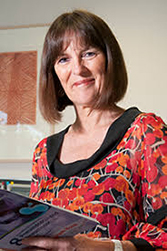 | By Ian Salek for the Rotary Radio Show on 94.1FM 3WBC An extract from the newsletter Networker 2020-2021 Edition 23 - Rotary District 9800 |
IS: | Amanda, welcome to the Rotary Radio Show. When did you commence your current role at the Menzies School of Health Research in Darwin? |
AL: | I began in late 1991. After working in London for a year, I returned to Darwin with my husband and children. A microbiologist had recently resigned from the Menzies School of Health Research, so I was given the task of working out what was causing very serious otitis media (middle ear infection) in remote Aboriginal children. |
IS: | Amanda what does your work currently involve? |
AL: | My work has shifted from laboratory to clinical trials research – from working out the microbiology to how to tackle that. When I began it was suspected that Chlamydia trachomatis (the cause of eye-lid scaring and blindness) may be involed in causing ear disease. But that was not the case. We were amazed that the onset of disease exactly coincided with the nasopharyngeal acquisition of several bacterial pathogens known to cause ear disease. The extraordinary finding was that this happened so early in life, and involved multiple sub-species (strains) simultanously. We continued to monitor these babies for two years. Many many strains of pathogens were acquired and ear disease and hearing loss persisted. That was not the pattern of ear disease seen in other populations, where the diveristy of germs is less, and ear problems are very transient. |
IS: | What then is the status of children’s ear health in the Aboriginal community in the Northern Territorry? Are you able to give us some stats? |
AL: | Yes. It is not a good picture where our research has focused on children on average up to 3 years of age. This is a most important age group, as it is the early years when auditory processing and language are still developing and that relies on hearing sounds and speech. We surveyed some 400 infants from birth to 3 years of age in four large communities. At One month – 40% had some form of ear disease (“glue ear”, bulging ear drums (full of pus), acute or chronic perforations (“runny ears”). At Two months – 50% had these problems. At Four months to Six Months – 80% and that is when ear drums start to burst. At Twelve months – 90% had a problem. At 3 Years the survey found there had been some improvement –with 75% having the same problem, but more have “runny ears”. |
IS: | Amanda what are the psychological effects of ear disease and hearing difficulties especially amongst indigenous children? |
AL: | Ear disease is not life threatening but it is life changing. Children need to hear to develop speech, to learn about sounds of their cultural heritage – birds, animals, songs, to learn English, to get the jokes at school, to play sport. If we can’t hear we drop out of the conversation—switch off. This happens to children, but too often they will not know why and unlike adults, cannot express their needs. Children with hearing loss are more likely to miss school, have poor school performance, that leads to interaction with youth justice and sadly greater incidence of child maltreatment. They are misunderstood. The majority of incarcerated Aboriginal people (men) have hearing loss, often undetected. |
IS: | How do you get out to the communities and can patients requiring surgery be brought back to Darwin? |
AL: | To visit communities in the Top End, it’s a flight in a small aircraft, or 4WD in central areas. Sometimes the drive can take 8 to 9 hours. You have got to time it to accommodate river crossings in flood and of course the crocodiles. Accommodation is limited. For ear surgery such as grommets or eardrum repair, Royal Darwin Hospital has a patient transfer service, but that’s complicated for families and small children. Most forms of ear disease should be treated by the community clinic, to prevent the need for hearing aids and surgery. |
IS: | Amanda what practical ways can Rotarians support your research or work in the field? |
AL: | Well yes. Currently we are working with twenty remote communities to train about five local community members as Ear Health Facilitators to regularly check kids’ ears and hearing. They would then love a T-Shirt with ‘Ear Heath Facilitator’ on it with a Menzies Health Research badge and maybe, if Rotary is able to assist, a Rotary badge. Donations are also appreciated and can be made at: https://www.goodcompany.com.au/au/charity/menzies-school-of-health-research/closing-the-gap-indigenous-children-s-health#checkout |